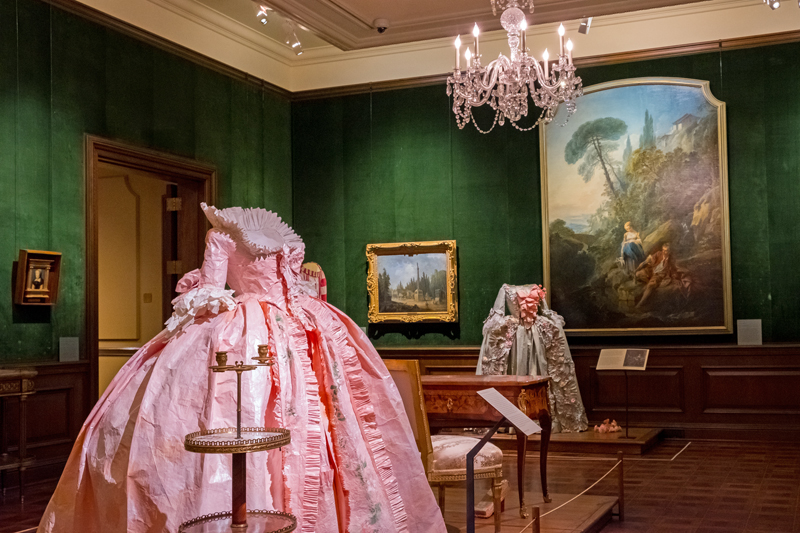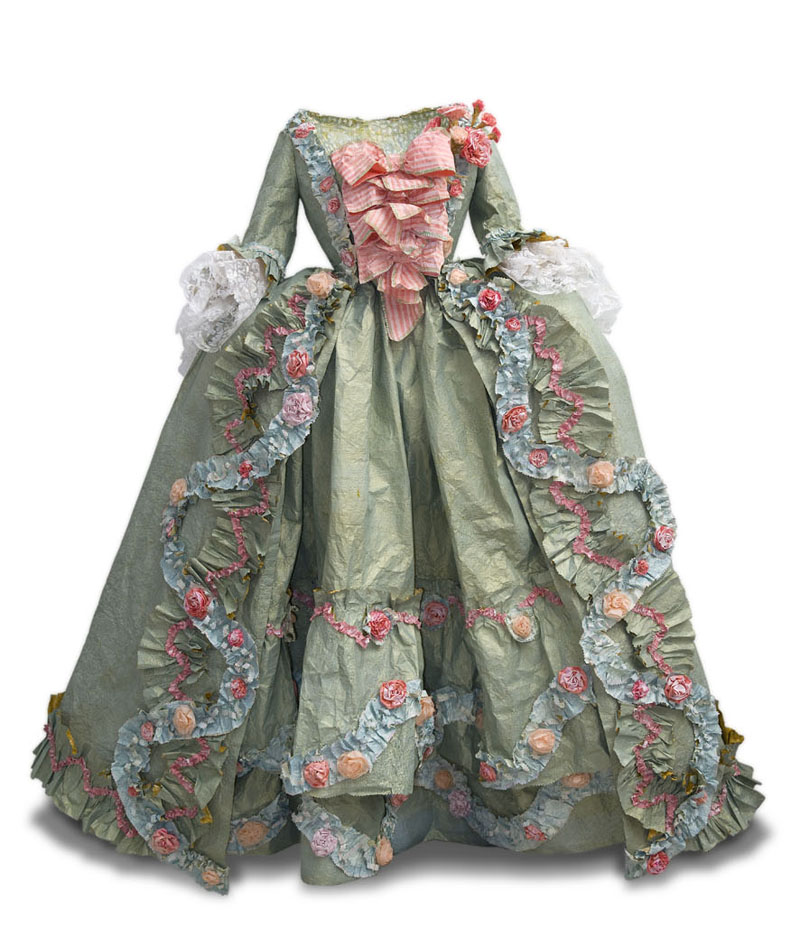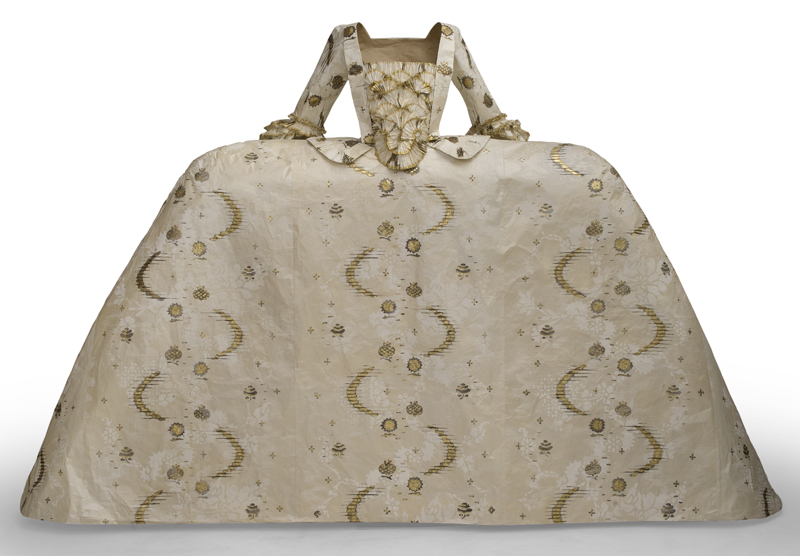"A Merry and Shameless Sham": 18th Century French Court Fashion
Papiers à la Mode is the first series of paper sculptures ever created by Isabelle de Borchgrave. Spanning more than three hundred years of fashion history, the collection recreates the visual illusion of fabrics and silhouettes using only paper, paint, tape, and glue. The project was done in collaboration with Rita Brown, a theatrical costume designer with expertise in historical patternmaking. Brown’s knowledge of period dress informed the historical details and construction while de Borchgrave brought her singular artistic sensibilities. From the beginning, it was Isabelle’s intention to do the sculptures “in the spirit” of the originals, not as exacting copies. She once said, “Papiers à la Mode is not about pastiche. It is a merry and shameless sham. Trompe l’oeil and nothing else.”
That phrase–“a merry and shameless sham”–has always reminded me of one of the most exuberant epochs of fashion history–the Rococo period of the 18th century. The era of opulence offers endless inspiration to de Borchgrave; more than a third of the sculptures from the Papiers à la Mode series interpret fashions from the 18th century.

Installation view of Isabelle de Borchgrave: Fashioning Art from Paper at The Frick Art Museum
The Rococo aesthetic prevailed for much of the 18th century, from approximately 1730 to 1780, reaching its apex in the 1750s. The movement influenced painting, sculpture, architecture, decorative arts, music, theatre, and fashion. Rococo designs tended to be lavishly ornate, with complex patterns in rich materials; color palettes were light and often pastel. There was an emphasis on whimsy, sensual pleasure, and fantasy, with overtones of artifice and display.
Rococo fashion was accordingly extravagant and is distinguished by exquisite fabrics and ornamentation including intricately patterned silk damasks and brocades, delicate laces, and luxurious embroideries and trimmings. Recreating the illusion of these opulent details in paper was an irresistible challenge to de Borchgrave.
The fashionable silhouette for women of the day was a narrow torso and full skirts–basically an upside down triangle sitting on top of a rectangle. Boned stays, the precursor of the 19th-century corset, shaped the upper half while structural undergarments known as panniers supported the wide skirts. A fitted overdress was worn open at the front to display the decorative bodice insert, or stomacher, and the voluminous drapery of the underskirt and petticoat. Formal court dress was so closely associates with Versailles and the French court that it became universally described as the robe à la française.
One of the most iconic images of the 18th century is a portrait of Madame de Pompadour, favored mistress of Louis XV, tastemaker, and patroness of the arts, painted by Francois Boucher in 1756. She wears a sumptuous silk taffeta robe à la française festooned with frills, ribbons, and silk flowers. The wide expanse of the garments served as a canvas and the whole look could be transformed by switching out the trimmings–the bows, lace, ribbons, and stomacher–which were supplied by marchands des modes, or fashion merchants. (The marchands des modes were somewhat of a cross between milliner and celebrity stylist and are often referred to as the ancestor of great Parisian couturiers of the 19th century.) By the last quarter of the eighteenth century, trimmings for formal dress had become increasingly elaborate, occasionally costing more than the dress fabric.

Isabelle de Borchgrave (Belgian, b. 1946), Madame de Pompadour Dress, 2011. Inspired by a 1756 portrait by François Boucher. Mixed media: paper, cut, folded, and molded with acrylic paint, ink, metallic powder, and adhesive; mounted on dress form.
At its most formal, the robe à la française could be almost comically wide. De Borchgrave based this work on an existing garment in the collection of the Victoria & Albert Museum in London.

Isabelle de Borchgrave (Belgian, b. 1946), Mantua, 2001.Based on a court mantua ca. 1750 in the collection of the Victoria and Albert Museum, London.
The wide-hooped skirts, considered stylish daywear earlier in the century, were already old fashioned by the 1750s, but women were still required to wear the cumbersome style to royal assemblies and balls. Imagine the skill required to navigate doorways and carriages gracefully while hauling a heavy, five-foot wide skirt.
Outside of court dress, fashion became less extravagant and shifted toward comfort and simplicity rather than display. The French Revolution decimated the fashion industry and fashion itself went out of taste.
In response to the artificiality and extravagance of court life, a starkly different style rose up influenced by the Neoclassical ideals in imitation of classical Greek and Roman dress. The fashion industry was later revitalized, although few ensuing eras could match the Rococo’s unique combination of excess, ornamentation, and theatricality.
Isabelle de Borchgrave: Fashioning Art from Paper is on view at The Frick Art Museum through January 6, 2019.
Installation view of Isabelle de Borchgrave: Fashioning Art from Paper at The Frick Art Museum
The Rococo aesthetic prevailed for much of the 18th century, from approximately 1730 to 1780, reaching its apex in the 1750s. The movement influenced painting, sculpture, architecture, decorative arts, music, theatre, and fashion. Rococo designs tended to be lavishly ornate, with complex patterns in rich materials; color palettes were light and often pastel. There was an emphasis on whimsy, sensual pleasure, and fantasy, with overtones of artifice and display.
Rococo fashion was accordingly extravagant and is distinguished by exquisite fabrics and ornamentation including intricately patterned silk damasks and brocades, delicate laces, and luxurious embroideries and trimmings. Recreating the illusion of these opulent details in paper was an irresistible challenge to de Borchgrave.
The fashionable silhouette for women of the day was a narrow torso and full skirts–basically an upside down triangle sitting on top of a rectangle. Boned stays, the precursor of the 19th-century corset, shaped the upper half while structural undergarments known as panniers supported the wide skirts. A fitted overdress was worn open at the front to display the decorative bodice insert, or stomacher, and the voluminous drapery of the underskirt and petticoat. Formal court dress was so closely associates with Versailles and the French court that it became universally described as the robe à la française.
One of the most iconic images of the 18th century is a portrait of Madame de Pompadour, favored mistress of Louis XV, tastemaker, and patroness of the arts, painted by Francois Boucher in 1756. She wears a sumptuous silk taffeta robe à la française festooned with frills, ribbons, and silk flowers. The wide expanse of the garments served as a canvas and the whole look could be transformed by switching out the trimmings–the bows, lace, ribbons, and stomacher–which were supplied by marchands des modes, or fashion merchants. (The marchands des modes were somewhat of a cross between milliner and celebrity stylist and are often referred to as the ancestor of great Parisian couturiers of the 19th century.) By the last quarter of the eighteenth century, trimmings for formal dress had become increasingly elaborate, occasionally costing more than the dress fabric.
Isabelle de Borchgrave (Belgian, b. 1946), Madame de Pompadour Dress, 2011. Inspired by a 1756 portrait by François Boucher. Mixed media: paper, cut, folded, and molded with acrylic paint, ink, metallic powder, and adhesive; mounted on dress form.
At its most formal, the robe à la française could be almost comically wide. De Borchgrave based this work on an existing garment in the collection of the Victoria & Albert Museum in London.
Isabelle de Borchgrave (Belgian, b. 1946), Mantua, 2001.Based on a court mantua ca. 1750 in the collection of the Victoria and Albert Museum, London.
The wide-hooped skirts, considered stylish daywear earlier in the century, were already old fashioned by the 1750s, but women were still required to wear the cumbersome style to royal assemblies and balls. Imagine the skill required to navigate doorways and carriages gracefully while hauling a heavy, five-foot wide skirt.
Outside of court dress, fashion became less extravagant and shifted toward comfort and simplicity rather than display. The French Revolution decimated the fashion industry and fashion itself went out of taste.
In response to the artificiality and extravagance of court life, a starkly different style rose up influenced by the Neoclassical ideals in imitation of classical Greek and Roman dress. The fashion industry was later revitalized, although few ensuing eras could match the Rococo’s unique combination of excess, ornamentation, and theatricality.
Isabelle de Borchgrave: Fashioning Art from Paper is on view at The Frick Art Museum through January 6, 2019.

